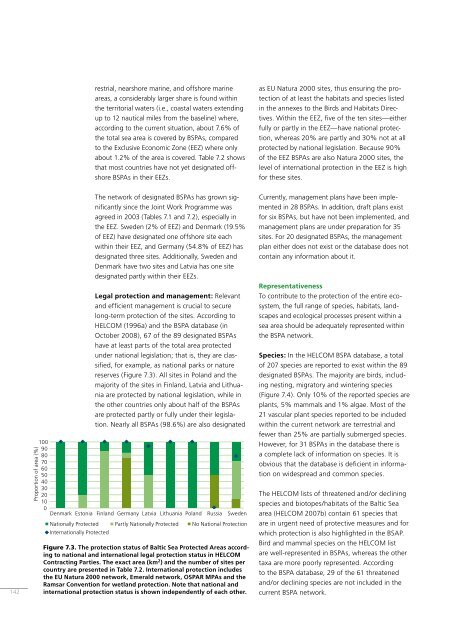BSEP116B Biodiversity in the Baltic Sea - Helcom
BSEP116B Biodiversity in the Baltic Sea - Helcom
BSEP116B Biodiversity in the Baltic Sea - Helcom
You also want an ePaper? Increase the reach of your titles
YUMPU automatically turns print PDFs into web optimized ePapers that Google loves.
estrial, nearshore mar<strong>in</strong>e, and offshore mar<strong>in</strong>e<br />
areas, a considerably larger share is found with<strong>in</strong><br />
<strong>the</strong> territorial waters (i.e., coastal waters extend<strong>in</strong>g<br />
up to 12 nautical miles from <strong>the</strong> basel<strong>in</strong>e) where,<br />
accord<strong>in</strong>g to <strong>the</strong> current situation, about 7.6% of<br />
<strong>the</strong> total sea area is covered by BSPAs, compared<br />
to <strong>the</strong> Exclusive Economic Zone (EEZ) where only<br />
about 1.2% of <strong>the</strong> area is covered. Table 7.2 shows<br />
that most countries have not yet designated offshore<br />
BSPAs <strong>in</strong> <strong>the</strong>ir EEZs.<br />
as EU Natura 2000 sites, thus ensur<strong>in</strong>g <strong>the</strong> protection<br />
of at least <strong>the</strong> habitats and species listed<br />
<strong>in</strong> <strong>the</strong> annexes to <strong>the</strong> Birds and Habitats Directives.<br />
With<strong>in</strong> <strong>the</strong> EEZ, five of <strong>the</strong> ten sites—ei<strong>the</strong>r<br />
fully or partly <strong>in</strong> <strong>the</strong> EEZ—have national protection,<br />
whereas 20% are partly and 30% not at all<br />
protected by national legislation. Because 90%<br />
of <strong>the</strong> EEZ BSPAs are also Natura 2000 sites, <strong>the</strong><br />
level of <strong>in</strong>ternational protection <strong>in</strong> <strong>the</strong> EEZ is high<br />
for <strong>the</strong>se sites.<br />
142<br />
Proportion of area (%)<br />
The network of designated BSPAs has grown significantly<br />
s<strong>in</strong>ce <strong>the</strong> Jo<strong>in</strong>t Work Programme was<br />
agreed <strong>in</strong> 2003 (Tables 7.1 and 7.2), especially <strong>in</strong><br />
<strong>the</strong> EEZ. Sweden (2% of EEZ) and Denmark (19.5%<br />
of EEZ) have designated one offshore site each<br />
with<strong>in</strong> <strong>the</strong>ir EEZ, and Germany (54.8% of EEZ) has<br />
designated three sites. Additionally, Sweden and<br />
Denmark have two sites and Latvia has one site<br />
designated partly with<strong>in</strong> <strong>the</strong>ir EEZs.<br />
Legal protection and management: Relevant<br />
and efficient management is crucial to secure<br />
long-term protection of <strong>the</strong> sites. Accord<strong>in</strong>g to<br />
HELCOM (1996a) and <strong>the</strong> BSPA database (<strong>in</strong><br />
October 2008), 67 of <strong>the</strong> 89 designated BSPAs<br />
have at least parts of <strong>the</strong> total area protected<br />
under national legislation; that is, <strong>the</strong>y are classified,<br />
for example, as national parks or nature<br />
reserves (Figure 7.3). All sites <strong>in</strong> Poland and <strong>the</strong><br />
majority of <strong>the</strong> sites <strong>in</strong> F<strong>in</strong>land, Latvia and Lithuania<br />
are protected by national legislation, while <strong>in</strong><br />
<strong>the</strong> o<strong>the</strong>r countries only about half of <strong>the</strong> BSPAs<br />
are protected partly or fully under <strong>the</strong>ir legislation.<br />
Nearly all BSPAs (98.6%) are also designated<br />
100<br />
90<br />
80<br />
70<br />
60<br />
50<br />
40<br />
30<br />
20<br />
10<br />
0<br />
Denmark Estonia F<strong>in</strong>land Germany Latvia Lithuania Poland Russia Sweden<br />
Nationally Protected<br />
Internationally Protected<br />
Partly Nationally Protected<br />
No National Protection<br />
Figure 7.3. The protection status of <strong>Baltic</strong> <strong>Sea</strong> Protected Areas accord<strong>in</strong>g<br />
to national and <strong>in</strong>ternational legal protection status <strong>in</strong> HELCOM<br />
Contract<strong>in</strong>g Parties. The exact area (km 2 ) and <strong>the</strong> number of sites per<br />
country are presented <strong>in</strong> Table 7.2. International protection <strong>in</strong>cludes<br />
<strong>the</strong> EU Natura 2000 network, Emerald network, OSPAR MPAs and <strong>the</strong><br />
Ramsar Convention for wetland protection. Note that national and<br />
<strong>in</strong>ternational protection status is shown <strong>in</strong>dependently of each o<strong>the</strong>r.<br />
Currently, management plans have been implemented<br />
<strong>in</strong> 28 BSPAs. In addition, draft plans exist<br />
for six BSPAs, but have not been implemented, and<br />
management plans are under preparation for 35<br />
sites. For 20 designated BSPAs, <strong>the</strong> management<br />
plan ei<strong>the</strong>r does not exist or <strong>the</strong> database does not<br />
conta<strong>in</strong> any <strong>in</strong>formation about it.<br />
Representativeness<br />
To contribute to <strong>the</strong> protection of <strong>the</strong> entire ecosystem,<br />
<strong>the</strong> full range of species, habitats, landscapes<br />
and ecological processes present with<strong>in</strong> a<br />
sea area should be adequately represented with<strong>in</strong><br />
<strong>the</strong> BSPA network.<br />
Species: In <strong>the</strong> HELCOM BSPA database, a total<br />
of 207 species are reported to exist with<strong>in</strong> <strong>the</strong> 89<br />
designated BSPAs. The majority are birds, <strong>in</strong>clud<strong>in</strong>g<br />
nest<strong>in</strong>g, migratory and w<strong>in</strong>ter<strong>in</strong>g species<br />
(Figure 7.4). Only 10% of <strong>the</strong> reported species are<br />
plants, 5% mammals and 1% algae. Most of <strong>the</strong><br />
21 vascular plant species reported to be <strong>in</strong>cluded<br />
with<strong>in</strong> <strong>the</strong> current network are terrestrial and<br />
fewer than 25% are partially submerged species.<br />
However, for 31 BSPAs <strong>in</strong> <strong>the</strong> database <strong>the</strong>re is<br />
a complete lack of <strong>in</strong>formation on species. It is<br />
obvious that <strong>the</strong> database is deficient <strong>in</strong> <strong>in</strong>formation<br />
on widespread and common species.<br />
The HELCOM lists of threatened and/or decl<strong>in</strong><strong>in</strong>g<br />
species and biotopes/habitats of <strong>the</strong> <strong>Baltic</strong> <strong>Sea</strong><br />
area (HELCOM 2007b) conta<strong>in</strong> 61 species that<br />
are <strong>in</strong> urgent need of protective measures and for<br />
which protection is also highlighted <strong>in</strong> <strong>the</strong> BSAP.<br />
Bird and mammal species on <strong>the</strong> HELCOM list<br />
are well-represented <strong>in</strong> BSPAs, whereas <strong>the</strong> o<strong>the</strong>r<br />
taxa are more poorly represented. Accord<strong>in</strong>g<br />
to <strong>the</strong> BSPA database, 29 of <strong>the</strong> 61 threatened<br />
and/or decl<strong>in</strong><strong>in</strong>g species are not <strong>in</strong>cluded <strong>in</strong> <strong>the</strong><br />
current BSPA network.

















